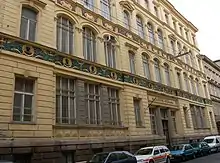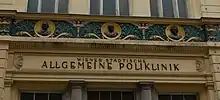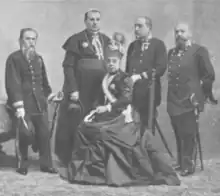General Polyclinic Vienna
The General Polyclinic (Allgemeine Poliklinik) was a hospital in Vienna where many well-known Austrian physicians worked.




From left, standing: August Leopold von Reuss, Emil Stoffella, Wilhelm Winternitz, Leopold Oser, Anton von Frisch, Hans von Hebra, Ludwig Fürth, Moriz Benedikt, Viktor Urbantschitsch, Max Herz, Anton Wölfler and Ludwig Bandl.
Founding
The polyclinic was founded in 1872 by twelve young university assistants, making it the first of its kind in Europe.[1] The novelty of the Vienna Polyclinic was that it sought to cover the entire range of medical subjects, whereas foreign polyclinics always focused on individual medical specialties. That is why this Viennese institution bore the name General Polyclinic. The founders were
- Heinrich Auspitz (1835–1886), dermatologist
- Friedrich Ludwig Fleischmann (1841–1878), pediatrician
- Jakob Hock (1831–1890), ophthalmologist
- Ignaz Neudörfer (1825–1898), surgeon
- Leopold Oser (1839–1910), internist[2]
- August Leopold von Reuss (1841–1924), ophthalmologist
- Carl von Rokitansky (1839–1924), gynecologist
- Emil Rollet (1835–1923), internist
- Johann Schnitzler (1835–1893), internist and laryngologist
- Mathias Schwanda (1821–1885), neurologist
- Robert Ultzmann (1842–1889), surgeon and urologist
- Wilhelm Winternitz (1834–1917), internist and hydrotherapist[3]
A few months later the following people joined:
- Alois Monti (1838–1909), pediatric diseases
- Viktor Urbantschitsch (1847–1921), diseases of the ear[4]
- Maximilian Leidesdorf (1816–1889), mood and nervous disorders
Other physicians:
- Josef von Metnitz (1861–1905), dentist
Significance
Already in its first year of operation, 12,000 patients were treated free of charge in 56,456 consultations, and lectures were given by 14 lecturers to 217 attendees.
Originally located on Wipplingerstrasse in the First District, these were outpatient clinics designed primarily to improve care for poor patients and to facilitate teaching and research work. The costs of the operation were initially borne by the founders themselves, but four years later an association was established to raise funds. Princess Pauline von Metternich in particular supported the association.[5]
In 1875, Leopold Oser, who was considered "Austria's only and best stomach specialist", introduced a flexible stomach tube instead of a rigid tube for gastroscopy, which the gastroenterologist Adolf Kußmaul had developed in 1867. This flexible gastric tube better adapted to the human anatomy and was able to both alleviate the discomfort of the examination and allow the physician to perform analyses of gastric function. It also prevented dangerous perforation of the esophagus or stomach, which was not uncommon with rigid gastroscopy and often fatal.
In 1875, the polyclinic moved to Oppolzergasse in the same district and in 1880 to Schwarzspanierstraße in the ninth district, where the first inpatient hospital operation with five beds was also started. In 1892, the polyclinic moved to the building in Mariannengasse, where it remained until the end.
The individual hospital departments, outpatient clinics and a lecture hall were gradually built here. From 1896 there was an X-ray cabinet, which in 1904 developed into the first X-ray institute in Austria. From 1898 to 1930, Julius Mannaberg served as head of the Internal Department of the Vienna General Polyclinic.
But other specialist departments were also established. Anton von Frisch (1849-1917), for example, founded the first urological outpatient clinic in Europe and succeeded in having urology installed as a separate subject at the University of Vienna. Hans Rubritius was head of urology from 1919 to 1943. Johann Schnitzler (1835-1893), Arthur Schnitzler's father, opened a laryngology department. Arthur Schnitzler himself also worked for him as an assistant until 1893. His work Professor Bernhardi, written in 1912, had the polyclinic as a model.
The polyclinic inspired the creation of numerous clinics throughout Europe around the turn of the century. It pioneered new therapies, such as the first hydrotherapeutic ward, established under Wilhelm Winternitz. Viktor Frankl headed the neurological department from 1946 to 1970.[6] Johannes Bischko established an acupuncture outpatient clinic, which became famous in 1972 with the first tonsil operation with acupuncture instead of anesthesia.[7] In 1975, the Ludwig Boltzmann Institute for Homeopathy was opened by Mathias Dorcsi (1923-2001).[8]
Nazi era
From 1938 the polyclinic was owned by the Municipality of Vienna. Reporting on March 28, 1938, shortly after Austria's Anschluss with Nazi Germany, Time magazine wrote of the devastating impact of the anti-semitic persecution of the many Jewish doctors on the polyclinic and other medical establishments in Vienna, listing the suicides.[9]
Postwar
It was briefly used as a geriatric rehabilitation center, but then finally closed on December 15, 1998. On the site, which apart from the building in Mariannengasse included other adjacent areas as far as Lazarettgasse, the Vienna Competence Center was built as a location for research institutions and companies from the fields of medicine, biomedicine, medical technology and complementary service areas.
Between 2008 and 2012, the landmark main building of the former Vienna Polyclinic as well as the adjacent buildings were completely renovated and transformed into a contemporary office and residence.
References
- "Spitäler". www.geschichtewiki.wien.gv.at (in German (formal address)). Retrieved February 1, 2022.
An privaten allgemein zugänglichen Spitälern traten zu den 'Barmherzigen Brüdern' und dem Hartmannspital vor allem das 1882 eröffnete Rudolfinerhaus, welches als Ausbildungsstätte für die Pflege im Spital große Bedeutung erlangte, und die 1871 von zwölf Dozenten der Universität gegründete Allgemeine Poliklinik als Ausbildungsstätte für Ärzte.
- "Leopold Oser". www.geschichtewiki.wien.gv.at (in German (formal address)). Retrieved February 4, 2022.
- "Wilhelm Winternitz". www.geschichtewiki.wien.gv.at (in German (formal address)). Retrieved February 4, 2022.
- Biographie, Deutsche. "Urbantschitsch, Viktor - Deutsche Biographie". www.deutsche-biographie.de (in German). Retrieved February 4, 2022.
- "40 Jahre Wiener Policlinik".
- "Viktor E. Frankl | Viktor Frankl Center Vienna". www.franklzentrum.org. Retrieved February 4, 2022.
- "Akupunktur | alle Informationen". institut-wolkenstein.com. Retrieved February 4, 2022.
- "Mathias Dorcsi". www.geschichtewiki.wien.gv.at (in German (formal address)). Retrieved February 4, 2022.
- "Medicine: Death & Doctors". Time. March 28, 1938. ISSN 0040-781X. Retrieved February 4, 2022.
n Vienna last week, as Nazis took possession of the world's greatest establishment for medical teaching—the University of Vienna's medical school (300 professors & lecturers), the General Hospital (over 2,000 beds), the polyclinic and nine other hospitals—a dread epidemic struck down many a great physician. Reported as suicides were: Professor Wolfgang Denk, 55, University & General Hospital chief surgeon, author of the textbook on surgery most widely used in Austria, no Jew. Professor Gabor Nobl, 74, Polyclinic skin & syphilis specialist, who shot his wife and himself. Professor Edmund Nobel, 54, baby specialist, who with the help of U. S. charity fed 400,000 Austrian children starving after the last War. Professor Arnold Baumgarten, 58, part-Jewish director of Vienna's largest city hospital (1,000 beds), onetime head of the Austrian State health department. Professor Moritz Oppenheim, 61, best skin specialist in Vienna. Professor Jonas Borak, X-ray specialist. Professor Gustav Bayer, 69, who with his daughter took morphine, turned on the gas and died in his home at Innsbruck.
Literature
External links
- General Polyclinic Vienna in Austria-Forum (in German) (at AEIOU)
- „Nur für Unbemittelte und vollkommen unentgeltlich“: Die Poliklinik – auf Spurensuche im Alten Medizinischen Wien (Folge 62) - Ärzte Woche, 18. Jahrgang Nr. 6, 2004
- 40 Jahre Wiener Poliklinik. Zur Feier des Bestandesjubiläums am 9. Mai. Mit 20 Illustrationen nach photographischen Aufnahmen von I. Michalup. In: Österreichs Illustrierte Zeitung, 19 May 1912, p. 13 (Online at ANNO)